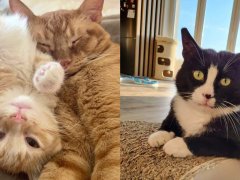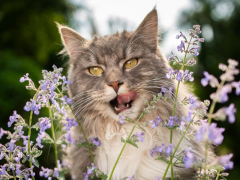
Amanda Campion / Cats.com
Bringing a new kitten into your home can be an exciting yet nerve-wracking experience for cat parents, especially if you already have a resident adult cat. You may wonder how your existing cat will react and whether they’ll accept the new kitten, wanting them to be friends immediately.
Key Takeaways
Curiosity over aggression: a curious, calm approach to the new kitten signals acceptance rather than hostility or aggression.
Willingness to share: your older cat sharing resources such as resting areas, their spaces, or food with the new kitten shows growing trust.
Affectionate interactions: mutual grooming, playing, and relaxed body language are signs of bonding between your cat and the new kitten.
Cats are incredibly territorial animals, and introducing a new feline companion can cause tension, stress, and anxiety. But your kitty can be encouraged to accept the new arrival with patience, time, and the right approach. In this article, we’ll explore the key signs that indicate your cat is receiving the new kitten in the introduction process, how to foster a healthy co-existing relationship, and the importance of being ‘Cat-Led.’
10 Signs That Your Cat Is Accepting a New Kitten
Let’s take a look at some common signs that your new feline family member is being welcomed, accepted and taken under the wing of your resident kitty.
1. Curiosity Instead of Aggression
One of the first positive signs that your resident pet is starting to accept the new kitten is curiosity over aggression. Initially, it’s common for the older cat to hiss, growl, or swat at the kitten. This is normal, so do not be alarmed, but this can also be apparent if introductions are rushed. However, if you notice your cat observing the kitten from a distance, sniffing their belongings, or cautiously approaching them without lashing out, it’s a sign that they’re beginning to accept the newcomer.
Cats are naturally territorial, and your resident cat will initially feel that the new kitten is an intruder. Over time, this resource-guarding behavior will likely shift toward curiosity as they realize the kitten is not a threat to them or their status in the home.
Encourage your cat to explore the new kitten’s scent by zone-swapping blankets or toys between them whilst initially keeping them physically separate using a barrier such as baby gates, so they can get used to each other without direct physical or visual interaction. This will help facilitate acceptance without causing additional stress. Once this is going well, you can move on to a visual introduction.
2. Sharing Resources
Territorial behavior often extends beyond a cat’s personal space and covers its resources. A significant sign of acceptance is when your older cat shares their resources with the new kitten. This could be their food bowls, toys, scratching posts, or favorite lounging and perching spots. While providing separate resources for each cat to prevent conflict is essential, voluntary sharing indicates that your cat feels comfortable and no longer views the kitten as competition.
Sometimes, you might notice your cat letting the kitten eat from their food bowl or play with their favorite toy. This acceptance reflects growing trust and comfort with the new kitten. However, don’t force resource sharing, as it could lead to stress. Cats should never have to choose between eating and forced contact. Instead, let it happen naturally over time as the bond between the two cats strengthens. It is essential always to feed cats apart from each other regardless of their bond, as eating is a solitary activity for cats.
3. Grooming Behavior

Mutual grooming is usually a sign of a strong, positive bond between cats. Amanda Campion / Cats.com
Mutual grooming is known as allogrooming and is one of the most evident signs of a growing bond between cats. Cats use grooming to establish trust, show affection, and reinforce social bonds. If you notice your older cat starting to groom the new kitten, it’s a positive indicator that they’re accepting them as part of their social family. Mutual grooming keeps each cat clean and helps them feel safe and comfortable with one another by transferring each other’s scent.
It’s important to note that grooming won’t happen right away, especially if your older cat is still adjusting. However, when it does occur, it’s a reassuring sign that the relationship is moving in the right direction.
4. Playing Together
Play is a vital part of the bonding process between cats. When you start seeing your older cat and new kitten engaging in playful social interactions, it’s an essential sign of acceptance. Play allows cats to explore each other’s boundaries, strengths, weaknesses, personalities, and energy levels in a non-threatening way. Look for playful chasing, gentle pawing, or mock pouncing—all of which are signs that your cat feels more at ease with the kitten and is forming a positive association.
Be mindful of the type of play, as rough or overly aggressive behavior can be mistaken for playfulness. If the interactions become too intense, intervene by redirecting their attention to toys or let them take some time out apart in a separate room. Over time, you should see more harmonious play sessions as your cat becomes more comfortable with the new addition, increasing the duration and frequency of these bonding sessions.
5. Positive Body Language
Reading your cat’s body language can provide valuable insight into their feelings about the new kitten. Positive body language cues include relaxed ears, slow blinking, and a soft, gently swaying rhythmic tail. These signs suggest that your cat is calm and content around the kitten.
On the other hand, if you notice signs of stress, such as flattened ears, narrowed eyes, a stiff posture, or a twitching tail, your cat may still be adjusting to the new situation. Over time, you should see a shift in their body language as they become more comfortable with the kitten’s presence.
6. Sleeping in Closer Proximity

Cats are vulnerable in sleep, so sleeping with a companion indicates trust and comfort. Kamila Kosiol / Shutterstock.com
Cats are very particular about their sleeping arrangements, seeking safe, secure spots where they feel completely relaxed. If your resident cat begins to sleep near the new kitten or allows the kitten to sleep close by to them —whether in the same room, on the same piece of furniture, or even snuggled up together—it’s a clear sign that they feel more comfortable with the kitten’s presence.
Cats that feel threatened or uneasy will often avoid close contact, especially during sleep, when they’re most vulnerable. So, when you notice your cat napping near the new kitten, it’s a strong indicator that the relationship is heading in the right direction.
7. Following the Kitten Around
If your cat begins to follow the new kitten around the home, it’s a sign that it’s interested in forming a bond. This behavior shows that your cat is curious and wants to spend time near the kitten. While it might look like stalking at first, as long as your cat isn’t displaying signs of aggression, this is typically a positive development. Allowing this behavior to play out is crucial so that you don’t intervene and disrupt the bonding process.
Following the kitten also allows your cat to observe their behavior and understand their routines. Over time, this can lead to more positive interactions.
8. Vocal Communication
Cats communicate not only through body language but also through vocalizations. If you notice your older cat chirping or trilling in the kitten’s presence, it’s a sign that they’re attempting to communicate in a friendly way. These vocalizations often express curiosity, affection, or an invitation to interact.
If your cat is growling or hissing, giving it space and time to adjust is essential. However, as their relationship with the kitten improves, you should hear more friendly vocalizations.
9. Head Bumping and Rubbing
Head bumping, or bunting, is a common way for cats to show affection and mark each other with their facial pheromones. If your older cat begins to head-butt or rub against the new kitten, it’s a sign that they accept them into their territory. This behavior is a form of scent marking that helps cats establish a social bond.
In addition to head bumping, you might notice your cat rubbing its face or body against the kitten. This indicates that your cat is becoming more comfortable and affectionate toward its new companion.
10. Reduced Signs of Stress or Aggression
Finally, one of the most reassuring signs that your cat is accepting the new kitten is reduced stress or aggressive behavior. Over time, you should see fewer instances of hissing, growling, or swatting as your cat adjusts to the new dynamic. You should see more displays of relaxed, friendly behaviors that indicate acceptance.
It’s important to remember that every cat is different, and the time it takes for your older cat to accept the new kitten can vary. Some cats may take a few days to adjust fully, while others may need weeks or months. Patience, understanding, and gradual phased introductions are vital to fostering a positive relationship between your cats.
How to Encourage Your Cat to Accept the New Kitten
If your cat is still adjusting to the new kitten, there are several steps you can take to encourage a smoother transition:
- Slow Introductions: Don’t rush the process. Swap zones and blankets before visual introductions begin to allow your cats to get to know each other’s scent.
- Provide Plenty of Space: Each cat should have its resources, including food bowls, litter boxes, and raised sleeping areas.
- Diffusers: Using synthetic pheromones and calming cat attractants (phytotherapy) can     facilitate a relaxing environment for both the newcomer and the resident cat
- Positive Reinforcement: Reward both cats with treats and praise when they interact calmly and positively. Aim for just a few minutes at a time initially and increase duration over time.
- Create a Safe Environment: Ensure both cats feel secure and have plenty of hiding spots to retreat if needed. Ideally, these should be raised at different levels for the age of the cat or kitten
- Consult a Veterinarian or Behaviorist: If tensions remain high, seeking professional advice sooner rather than later can help ease the transition before too many negative developments occur.
Bringing a new kitten into your home can be a big adjustment for you and your older cat. However, with patience and careful introductions, most cats can learn to accept and even enjoy their new companion. By looking for signs of curiosity, playfulness, grooming, and shared spaces, you can tell when your cat is starting to accept the new kitten. Over time, these behaviors will strengthen the bond between your two feline companions, creating a more harmonious household.
Frequently Asked Questions
How long does it take for a cat to accept a new kitten?
The time it takes for a cat to accept a new kitten can vary greatly depending on the temperament and personality of both cats. Some cats may show signs of curiosity and acceptance within a few days, while others may take weeks or months to thoroughly accept the new addition. Gradual introductions, patience, and a positive, stress-free environment are essential for a successful transition.
What should I do if my older cat aggressively approaches the new kitten?
If your older cat is aggressive toward the new kitten, it’s essential to separate them immediately and give them time to adjust. Introductions should be done gradually, allowing each cat first to become familiar with the other’s scent. Keep initial face-to-face meetings short and supervised, and use positive reinforcement to reward calm behavior. If the aggression persists, consult a veterinarian or animal behaviorist for additional guidance. Their knowledge can ease this process for you and your cats.
Can two cats eventually become friends if they don’t initially get along?
Yes, it’s possible for two cats who don’t get along initially to become friends or at least tolerate each other and co-exist. Cats are territorial animals, and it may take time to feel comfortable sharing space with a new kitten. Most cats will learn to tolerate each other with proper introductions, patience, and positive reinforcement. Some may even develop a strong bond over time, especially if they engage in play and mutual grooming.
-
Crowell-Davis, S. L., Curtis, T. M., & Knowles, R. J. (2004b). Social organization in the cat: A modern understanding. Journal of Feline Medicine and Surgery, 6(1), 19–28. https://doi.org/10.1016/j.jfms.2003.09.013
-
Understanding Feline Social Structure. (2019). The University of Edinburgh.







